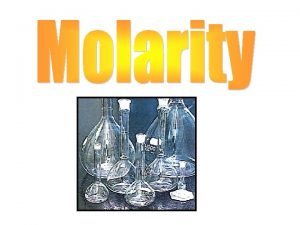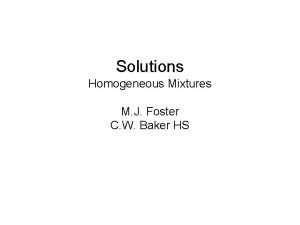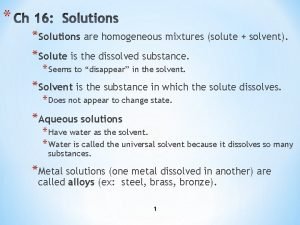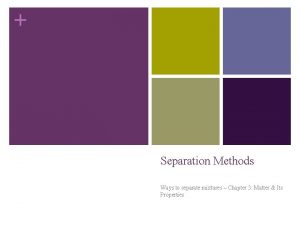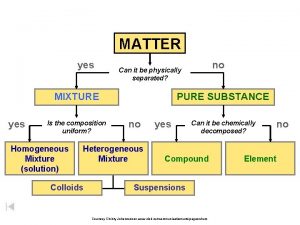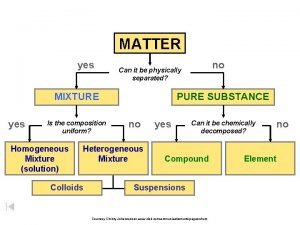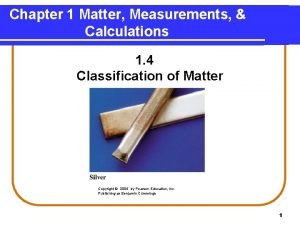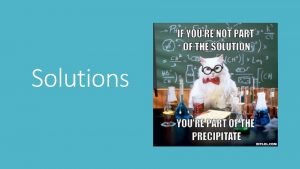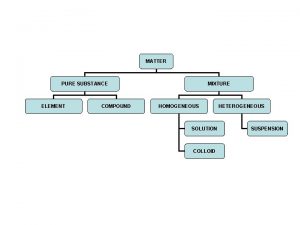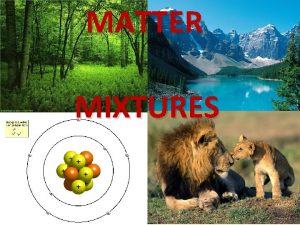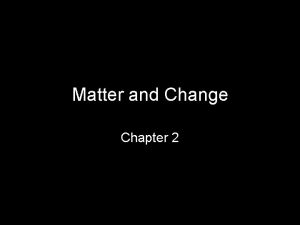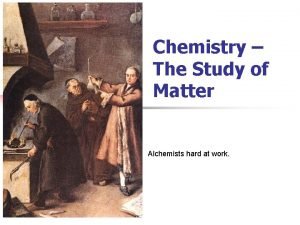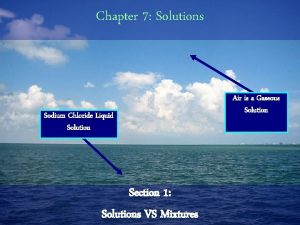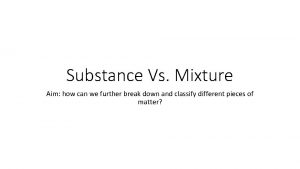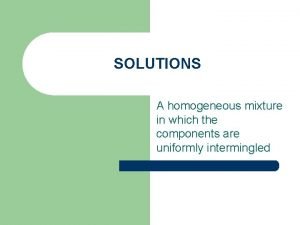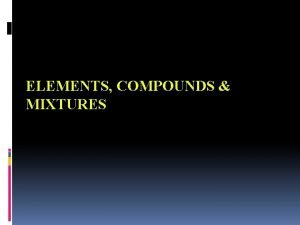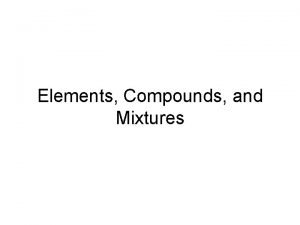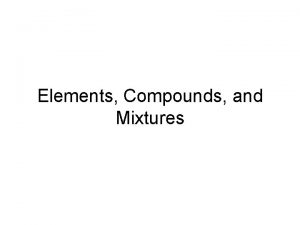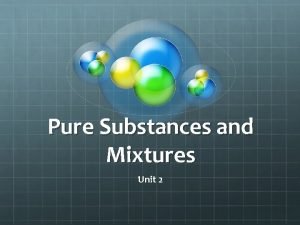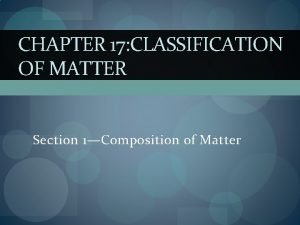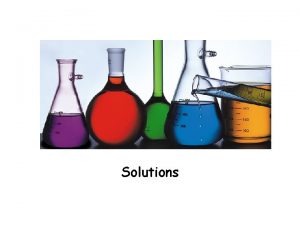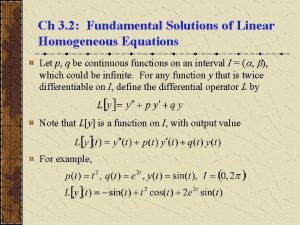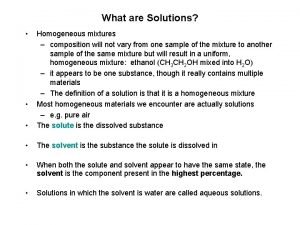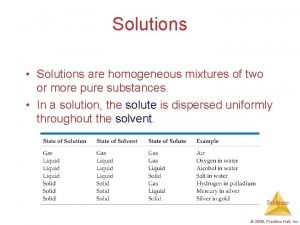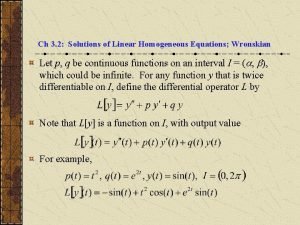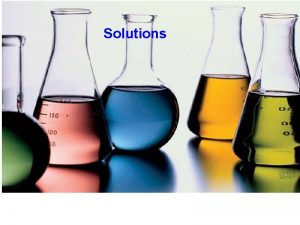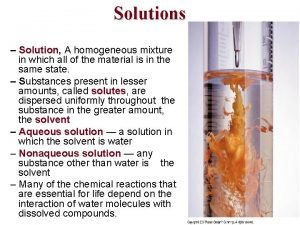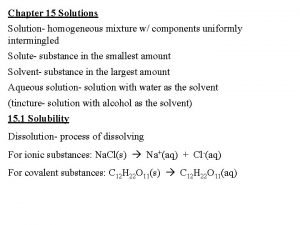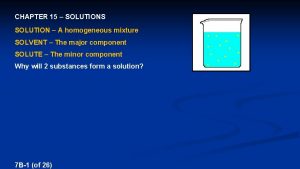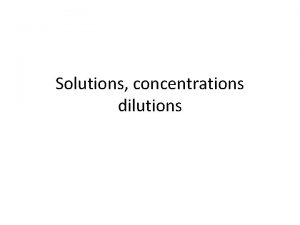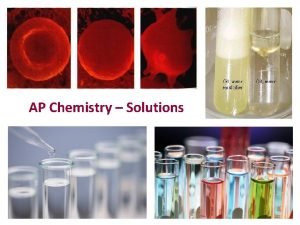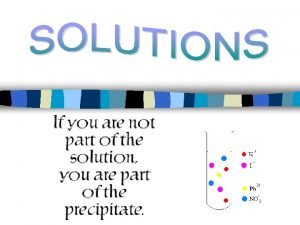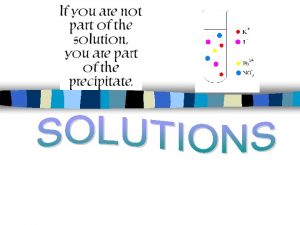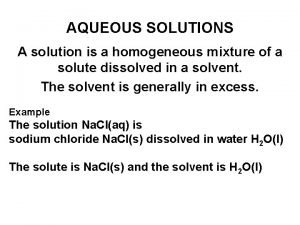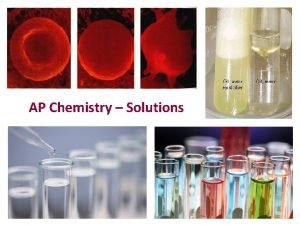Solutions Chapter 13 Solution Process Solution homogeneous mixture








































- Slides: 40

Solutions Chapter 13

Solution Process Solution – homogeneous mixture of solute and solvent Ø Ø Can be gases, liquids, or solids Solvent is component present in the largest amount (rest are solutes) Intermolecular forces are rearranged with solutions of condensed phases. Ø Ex. Na. Cl in Water – Water molecules orient themselves on Na. Cl; H-bonds between waters have to be broken; Na. Cl dissociates; ion-dipole forces form; interaction is called solvation or hydration


The Solution Process

Energy Changes Three steps involving energy in the formation of a solution Ø Ø Ø Enthalpy change in the solution process Ø Separation of solute molecules (∆H 1) Separation of solvent molecules (∆H 2) Formation of solute-solvent interactions (∆H 3) ∆Hsoln = ∆H 1 + ∆H 2 + ∆H 3 ∆Hsoln can be + or – Ø Ø Breaking attractive intermolecular forces is always endothermic (+) Forming attractive intermolecular forces is always exothermic (-)

Energy changes


Energy Changes and Solution Formation In general, solutions form if ∆Hsoln is negative. Ø If ∆Hsoln is too endothermic a solution will not form. “Rule of Thumb” – Like dissolves Like Ø Ø Polar solvents dissolve polar solutes Nonpolar solvents dissolve nonpolar solutes Ex. Na. Cl in gasoline: Only weak interactions are possible because gasoline is nonpolar; interactions do not compensate for separation of ions; Na. Cl does not dissolve to any great extent in gasoline.

Solution Formation: Spontaneity and Disorder Spontaneous process occurs without outside intervention Ø Ø Ø Energy of system decreases – spontaneous Tend to be exothermic Some are endothermic Entropy is a measure of randomness or disorder of a system. Ø Ø Solution formation is favored by the increase in entropy that accompanies solution formation (most cases) A solution can spontaneously mix when Esoln is not significantly decreasing when entropy is increasing.

Solution Formation: Chemical vs. Physical Solutions can be created physically or chemically. Ni(s) + 2 HCl(aq) Ni. Cl 2(aq) + H 2(g) Ø Ø Chemical form has changed (Ni Ni. Cl 2) When water is removed, no Ni is found (only Ni. Cl 2 remains) Na. Cl(s) + H 2 O(l) Na+(aq) + Cl-(aq) Ø When water is removed from the solution, Na. Cl is found.

Solubility Dissolution – formation of a solution Crystallization – “destruction” of a solution If these processes are in equilibrium, the solution is saturated. Solubility is the amount of solute required to form a saturated solution. Ø Ø Unsaturated Supersaturated

Factors affecting Solubility Nature of the solute and solvent Ø Ø Temperature Ø Ø Intermolecular forces – favorable? Miscible vs. immiscible Generally, as temperature increases, solubility increases. Sometimes not the cases – gases are less soluble at higher temperatures Pressure Ø Ø Ø Solubility of a Gas is a function of the pressure of the gas over the solution. Increase pressure, increase solubility Henry’s Law – Sg = k. Pg

Solubility: Pressure



Concentration Amount of solute per amount of solvent Qualitative – dilute vs. concentrated Quantitative – Ø Ø Mass percentage Mole fraction Molarity Molality

Concentration

Molality – Molarity

Colligative Properties Colligative properties depend on quantity of solute molecules. Ø (E. g. freezing point depression and melting point elevation. ) Lowering Vapor Pressure Ø Ø Ø Non-volatile solutes reduce the ability of the surface solvent molecules to escape the liquid. Therefore, vapor pressure is lowered. The amount of vapor pressure lowering depends on the amount of solute.

Vapor Pressure

Colligative Properties Lowering Vapor Pressure Ø Ø Raoult’s Law: PA is the vapor pressure with solute, PA is the vapor pressure without solute, and A is the mole fraction of A, then Recall Dalton’s Law:

Colligative Properties Lowering Vapor Pressure Ø Ø Ideal solution: one that obeys Raoult’s law breaks down when the solvent-solvent and solute-solute intermolecular forces are greater than solute-solvent intermolecular forces. Boiling-Point Elevation Ø Ø Ø Goal: interpret the phase diagram for a solution. Non-volatile solute lowers the vapor pressure. Therefore the triple point - critical point curve is lowered


Colligative Properties: Boiling-Point Elevation At 1 atm (normal boiling point of pure liquid) there is a lower vapor pressure of the solution. Therefore, a higher temperature is required to teach a vapor pressure of 1 atm for the solution ( Tb). Molal boiling-point-elevation constant, Kb, expresses how much Tb changes with molality, m:

Colligative Properties: Freezing Point Depression At 1 atm (normal boiling point of pure liquid) there is no depression by definition When a solution freezes, almost pure solvent is formed first. Ø Therefore, the sublimation curve for the pure solvent is the same as for the solution. Ø Therefore, the triple point occurs at a lower temperature because of the lower vapor pressure for the solution.

Colligative Properties: Freezing Point Depression • • • The melting-point (freezing-point) curve is a vertical line from the triple point. The solution freezes at a lower temperature ( Tf) than the pure solvent. Decrease in freezing point ( Tf) is directly proportional to molality (Kf is the molal freezing-point-depression constant):


Osmosis Semipermeable membrane: permits passage of some components of a solution. Ø Example: cell membranes and cellophane. Osmosis: the movement of a solvent from low solute concentration to high solute concentration. There is movement in both directions across a semipermeable membrane. As solvent moves across the membrane, the fluid levels in the arms becomes uneven.

Osmosis Eventually the pressure difference between the arms stops osmosis.

Osmosis Osmotic pressure, , is the pressure required to stop osmosis: Isotonic solutions: two solutions with the same separated by a semipermeable membrane.

Osmosis Hypotonic solutions have a lower than a more concentrated solution. Hypertonic solutions have a higher than a more dilute solution. Osmosis is spontaneous.

Ex. Red blood cells are surrounded by semipermeable membranes. Crenation: Ø red blood cells placed in hypertonic solution (relative to intracellular solution); Ø there is a lower solute concentration in the cell than the surrounding tissue; Ø osmosis occurs and water passes through the membrane out of the cell. Ø The cell shrivels up.

Ex. Red blood cells are surrounded by semipermeable membranes.

Ex. Red blood cells are surrounded by semipermeable membranes. Hemolysis: Ø red blood cells placed in a hypotonic solution; Ø there is a higher solute concentration in the cell; Ø osmosis occurs and water moves into the cell. Ø The cell bursts. To prevent crenation or hemolysis, IV (intravenous) solutions must be isotonic.

Colloids Colloids are suspensions in which the suspended particles are larger than molecules but too small to drop out of the suspension due to gravity. Particle size: 10 to 2000 Å. Tyndall effect: ability of a Colloid to scatter light. The beam of light can be seen through the colloid.

Types of Colloids aerosol (gas + liquid or solid, e. g. fog and smoke), foam (liquid + gas, e. g. whipped cream), emulsion (liquid + liquid, e. g. milk), sol (liquid + solid, e. g. paint), solid foam (solid + gas, e. g. marshmallow), solid emulsion (solid + liquid, e. g. butter), solid sol (solid + solid, e. g. ruby glass).

Hydrophobic and Hydrophilic Colloids Focus on colloids in water. Ø Ø “Water loving” colloids: hydrophilic. “Water hating” colloids: hydrophobic. Molecules arrange themselves so that hydrophobic portions are oriented towards each other.

Hydrophobic and Hydrophilic Colloids Typical hydrophilic groups are polar (containing C-O, O-H, N-H bonds) or charged. Hydrophobic colloids need to be stabilized in water. Adsorption: when something sticks to a surface we say that it is adsorbed. Ø If ions are adsorbed onto the surface of a colloid, the colloids appears hydrophilic and is stabilized in water.

Removal of Colloid Particles Colloid particles are too small to be separated by physical means (e. g. filtration). Colloid particles are coagulated (enlarged) until they can be removed by filtration. Methods of coagulation: Ø heating (colloid particles move and are attracted to each other when they collide); Ø adding an electrolyte (neutralize the surface charges on the colloid particles).

Dialysis: Removal of Colloids Semipermeable membrane is used to separate ions from colloidal particles. Blood passes through a membrane immersed in a washing solution. Ø Ø Washing solution is isotonic with ions that must be retained. Washing solution does not contain waste products. Washing solution removes (dialyzes) wastes and the “good” ions remain.
 Is 14 karat gold homogeneous or heterogeneous
Is 14 karat gold homogeneous or heterogeneous What is a solution homogeneous mixture
What is a solution homogeneous mixture Is a solution a homogeneous mixture
Is a solution a homogeneous mixture Homogeneous mixture
Homogeneous mixture Homogeneous and non homogeneous differential equation
Homogeneous and non homogeneous differential equation Homogeneous mixture of a solute in a solvent
Homogeneous mixture of a solute in a solvent Decanting
Decanting Uniform in composition
Uniform in composition Is the composition uniform?
Is the composition uniform? State of matter
State of matter Granola homogeneous or heterogeneous
Granola homogeneous or heterogeneous Non examples of homogeneous mixture
Non examples of homogeneous mixture Blood a homogeneous mixture
Blood a homogeneous mixture Why is vinegar a homogeneous mixture
Why is vinegar a homogeneous mixture Elements and compounds worksheet
Elements and compounds worksheet Homogeneous mixture
Homogeneous mixture What is a heterogeneous mixture?
What is a heterogeneous mixture? Homogeneous mixture
Homogeneous mixture Heterogeneous mixture
Heterogeneous mixture Homogeneous mixture
Homogeneous mixture Homogeneous mixture
Homogeneous mixture Is orange juice homogeneous or heterogeneous
Is orange juice homogeneous or heterogeneous Homogeneous mixture particle diagram
Homogeneous mixture particle diagram Is wine a homogeneous mixture
Is wine a homogeneous mixture Homogeneous mixture
Homogeneous mixture Solutions and mixtures
Solutions and mixtures Compound and mixture
Compound and mixture Is maple syrup a homogeneous mixture
Is maple syrup a homogeneous mixture Hungry slide
Hungry slide Heterogeneous
Heterogeneous Homogeneous mixture
Homogeneous mixture Maple syrup homogeneous or heterogeneous
Maple syrup homogeneous or heterogeneous Are pure substances homogeneous
Are pure substances homogeneous Is permanent press fabric a homogeneous mixture
Is permanent press fabric a homogeneous mixture Are solutions homogeneous
Are solutions homogeneous Are all solutions homogeneous mixtures
Are all solutions homogeneous mixtures Fundamental solutions of linear homogeneous equations
Fundamental solutions of linear homogeneous equations Gaseous solution
Gaseous solution Are solutions homogeneous
Are solutions homogeneous Fundamental solutions of linear homogeneous equations
Fundamental solutions of linear homogeneous equations Are all aqueous solutions homogeneous
Are all aqueous solutions homogeneous

